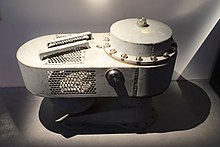Submarine snorkel
[1] Until the advent of nuclear power, submarines were designed to operate on the surface most of the time and submerge only for evasion or for daylight attacks.
However, with continued radar improvement as the war progressed, submarines (notably, the German U-boats in the Battle of the Atlantic) were forced to spend more time underwater, running on electric motors that gave speeds of only a few knots and very limited range.
[4][5] The Royal Netherlands Navy had been experimenting as early as 1938 with a simple pipe system on the submarines O-19 and O-20 that enabled diesel propulsion at periscope depth, while also charging the batteries.
The Kriegsmarine first viewed the snorkel as a means to take fresh air into the boats but saw no need to run the diesel engines under water.
An electrical circuit controls a compressed air system that holds a "head valve" open against the pull of a powerful spring.
When waves wash over exposed contacts, the control circuit breaks, venting the compressed air, causing the head valve to slam shut.
During the early months of the Battle of the Atlantic in World War II, British ships using the radar set Model 271 were able to detect the periscope of a submerged submarine at a distance of 800 m (0.50 mi) during tests in 1940.

